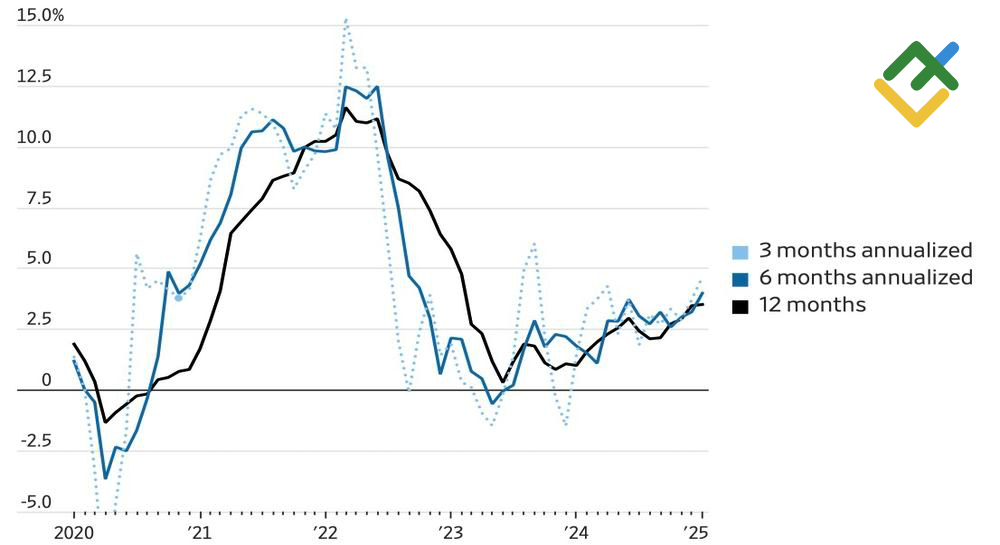
The US has decided to postpone the implementation of reciprocal tariffs until April 1, encouraging other countries to reduce their barriers to US exports and enter into negotiations. This development, in conjunction with the ongoing hopes for a ceasefire in Eastern Europe, has strengthened the EURUSD pair. Let’s discuss this topic and make a trading plan.
The article covers the following subjects:
Major Takeaways
- The White House will not impose reciprocal tariffs until April 1.
- The US PCE index will likely slow to 2.5–2.6% in January.
- Rumors of peace talks on Ukraine support the euro.
- The EURUSD pair’s correction towards 1.0535 and 1.061 is gaining traction.
Weekly US Dollar Fundamental Forecast
The gap between stated intentions and subsequent actions has been a recurring theme in the analysis of President Donald Trump’s economic policies. During the election campaign, Trump made several statements that led investors to anticipate a trade war with potentially beneficial outcomes for the US dollar. However, subsequent actions by the White House have suggested a shift towards negotiations rather than aggressive protectionism. As a result, investors have become increasingly confident that the implementation of significant import duties is unlikely. This shift in market sentiment has allowed investors to explore riskier assets, such as the EURUSD pair.
Another retreat from the radical trade policy was the signing of Donald Trump’s memorandum on reciprocal tariffs, which instructs the administration to examine unfair trade practices of other countries against the US and prepare a report by April 1. Thus, import duties will not be imposed until that date, which allowed the world to take a breather.
Notably, India, Brazil, Vietnam, Argentina, and other countries have the highest tariffs against US firms, while China, Mexico, Canada, the EU, and Japan do not have such tariffs, despite the US having a foreign trade deficit with these countries. The investigation will also examine non-tariff barriers, particularly the value-added tax. In this regard, Brussels and Tokyo should be particularly concerned.
US Producer Price Index
Source: Wall Street Journal.
The lower the final tariffs are, the less inflation risks running rampant. Before President Trump’s return to the White House, inflation was already high. This is evidenced by the significant increase in the producer price index (PPI) to 0.4% m/m and 3.5% y/y in January. In contrast to the US President’s first term, when protectionism helped the Fed achieve its 2% inflation target, concerns have been raised that President Trump’s policies may hinder the US regulator’s ability to meet this target.
At the same time, the EURUSD pair exhibited optimism in response to the US PPI data, which, in conjunction with the CPI, contributed to a comprehensive assessment of the Personal Consumption Expenditure Index, which is anticipated to decelerate from 0.4% to 0.2–0.3% m/m and from 2.8% to 2.5–2.6% y/y in January. Consequently, the derivatives market increased the likelihood of two federal funds rate cuts in 2025 from 30% to 38%, which, along with declining risks of a global trade war and rumors of an imminent start of ceasefire talks in Eastern Europe, led to a weakening of the US dollar.
Weekly EURUSD Trading Plan
Therefore, Donald Trump’s decision to postpone tariffs has led to a delay in the EURUSD‘s slide to parity. The major currency pair had an opportunity to develop a full-fledged correction, also due to the improved prospects for European business and public finances in case the armed conflict in Ukraine is over. Against this backdrop, one can keep their long trades open until the pair reaches the targets of 1.0535 and 1.061.
This forecast is based on the analysis of fundamental factors, including official statements from financial institutions and regulators, various geopolitical and economic developments, and statistical data. Historical market data are also considered.
Price chart of EURUSD in real time mode
The content of this article reflects the author’s opinion and does not necessarily reflect the official position of LiteFinance broker. The material published on this page is provided for informational purposes only and should not be considered as the provision of investment advice for the purposes of Directive 2014/65/EU.
According to copyright law, this article is considered intellectual property, which includes a prohibition on copying and distributing it without consent.
{{value}} ( {{count}} {{title}} )
This post is originally published on LITEFINANCE.





